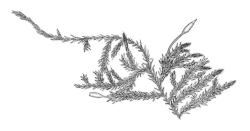- ≡ Macromitrium sect. Macrocoma Müll.Hal., Bot. Zeitung (Berlin) 3: 522 (1845)
The following generic description is modified from Vitt 1994; it does not encompass the variation of the subgenus Trachyphyllum.
Plants slender, dull, forming loose and often extensive mats on bark. Stems creeping and elongate, irregularly to subpinnately branched. Stem leaves appressed when dry, weakly spreading when moist. Branch leaves equal or slightly shorter than stem leaves, appressed, and not contorted when dry, erect-spreading or rarely (in N.Z. material) squarrose when moist, not fragile, keeled; margins entire, plane or recurved; upper laminal cells small and rounded, isodiametric to short-elliptic, flat or bulging, singly papillose or smooth, unistratose; inner basal laminal cells short, bulging and singly papillose. Costa single, prominent, usually percurrent, sometimes producing abaxial rhizoids (in non-N.Z. species), with abaxial surface mostly covered with lamina-like cells. Gemmae rare.
Sexuality autoicous (in N.Z. material) or dioicous (and then male plants well-developed). Perichaetial leaves enlarged. Perigonia lateral, often on short branches. Setae elongate, smooth; capsules ± cylindric-ellipsoid, plicate at mouth or throughout. Stomata superficial, restricted to the neck and lower portion of the urn, the guard cells sometimes poorly differentiated; operculum rostrate from a conic base. Peristome double, single, or lacking, often double and reduced as in N.Z. species. Calyptra enclosing the entire capsule, plicate, densely hairy, and often with1 deep slit. Spores rather large for the family, 1-celled and isosporous.
Vitt (1980a) recognised nine species of Macrocoma. The genus is most diverse in Central and South America, but there are endemic species in eastern and southern Africa, and in the Himalayan region. Two widespread species (M. orthotrichoides and M. tenue) account for much of the geographic distribution of the genus. The one species occurring in N.Z. is variable and broadly distributed here.
The type of Macrocoma was designated by Vitt (1980a) to be M. filiforme (Hook. & Grev.) Grout. However Vitt (1994) subsequently indicated this name to be illegitimate and synonymous with the Brazilian M. orthotrichoides (Raddi) Wijk & Margad. Macrocoma orthotrichoides is considered by Tropicos (accessed 18 Jan. 2016) to be the generic type.
The concept of Macrocoma was broadened by Vitt (1980a) to include two exclusively South American species previously treated as Macromitrium subgenus Trachyphyllum Broth. Macrocoma subgenus Trachyphyllum (Broth.) Vitt is distinguished by, inter alia, squarrose to widely recurved leaves, elongate cells on the abaxial costal surface, and naked calyptrae.
In a companion publication, Vitt (1980b) performed a morphometric study of the "Macrocoma tenue-M. sullivantii species complex", sampling such features as leaf length variation, the number of cells in the leaf apex, and apical cell length from collections from up to ten geographic regions. He divided M. tenue (Hook. & Grev.) Vitt into subsp. tenue from N.Z., eastern Australia, and eastern Africa and subsp. sullivantii from the southern Appalachian Mountains, eastern Asia including Japan, Central and South America, and Hawai‘i. Since Vitt’s study is the most detailed of Macrocoma, his taxonomy is followed here. According to Vitt, the subsp. tenue is "based on the presence of a peristome reduced to a low, double membrane, and non-fragile branch leaves that are differentiated from the stem leaves and have incurved tips and flat, uniform upper cells".
| Category | Number |
|---|---|
| Indigenous (Non-endemic) | 1 |
| Total | 1 |




